Women in Thai Cuisine (Part 3): The Modern Era
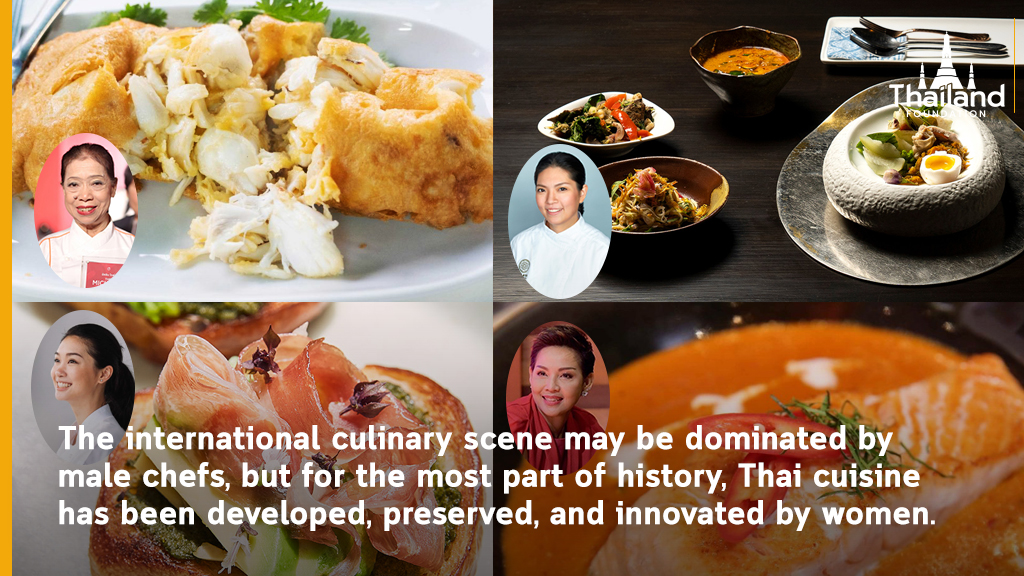
In the first episode of the Women in Thai Cuisine series, we have learned about the ladies in the royal kitchen during the first period of Rattanakosin (1782) – Queen Sri Suriyendra whose culinary skill was celebrated in a classic poem, and Thao Thong Kip Ma, an international woman who was regarded as the Queen of Thai desserts. In the second episode, our journey took us through the era of change in 1851 when Thailand embraced Western cultures and technological advances. We know Lady Plian, an excellent cook and author of the first Thai cookbook and founder of the Thai Red Cross, and Princess Consort Saisavali Bhiromya, one of the first food innovators and female social workers.
In this last episode of the series, we take a peek at the modern era of Thai food and how modern Thai women build on the culmination of centuries of Thai cuisine.
Thai food today
Today, Thai food today is more cosmopolitan and savored all over the world. According to the World’s 50 Best Food by CNN Travel 2021, Thai massaman curry [แกงมัสมั่น] took the first place, followed by tom yum goong [ต้มยำกุ้ง] at the eighth and som tam [ส้มตำ] at the forty-sixth. These three dishes are the stars of their own tiers. Massaman curry has a complicated preparation and complex yet mellow flavor profile typical of the Thai royal cuisine. Tom yum goong allows a larger room for spiciness and a simpler method perfect for a home-cooked dish. Som tam is a flavor bomb, attacking you with a sour punch, hot sensation from chili and a playful sweetness. Its one-step wonder is to mix all ingredients with a mortar and pestle. Undoubtedly, it is the number one street food for Thais. The fact that the three siblings claim spots on the global ranking shows that Thai food is vibrant at every level. Nowadays as many talented male chefs are emerging, women still maintain a strong presence in the cooking scene whether as home cooks, street food vendors, or even world-class chefs. Let me introduce you to four female chefs who represent modern Thai cuisine.
Jay Fai (Supinya Junsuta): The icon of Thai street food
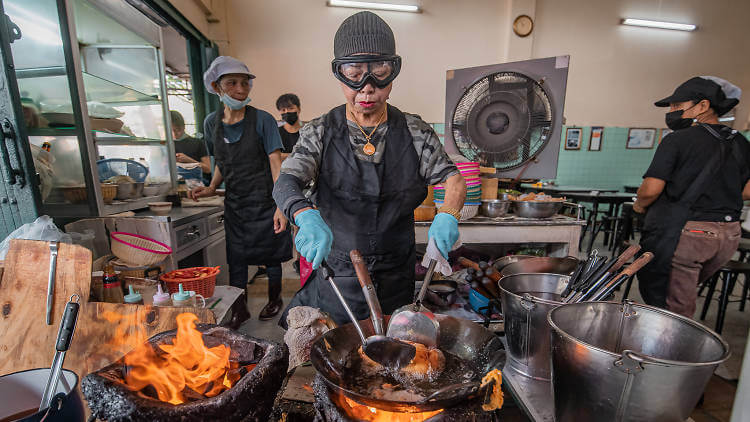
[cr. TimeOut]
Jay Fai, aged 77, is the owner of a one-Michelin star bistro. A common sight is Jay Fai wearing black goggles to protect her eyes, standing in front of the stove, and cooking skillfully. Her cozy and humble ran tam sung [ร้านตามสั่ง – bistro] has been running for 40 years. With this level of success, you may assume that she had been cooking from the start, but that wasn’t the case. Jay Fai came from a modest background, her mother selling noodles while her father not contributing much to the household to say the least. Jay Fai was a seamstress and just when she had some savings, a fire accident reduced her hard-earned wages to ash.
Refusing to fail a second time, Jay Fai devoted herself to cooking with her mother. At 35, she started a small street food stall business before opening a proper restuarant. With a huge investment, she added pricey banana prawns in Pad Thai and sold at 120 baht (normal street food in Thailand costs 40-60 baht per dish). Her customers had doubts at first, but they returned after tasting it. She then scouted for the best seafood for her delicious Thai dishes and her consumer base keeps expanding ever since.
- Michelin star street food
The next step is to offer something different. Jay Fai dreamed of making one-of-a-kind crab omelet. She threw in half a kilo of crabmeat into egg batter, deep frying it in hot oil, and folding the egg to cover the crabmeat completely. The result was a beautiful presentation. The egg was crunchy crispy golden on the outside contrast with the juicy white crabmeat stuffed inside. This talk of the town “crab omelet” fast became her signature dish and big break.
In 2018, Jay Fai was award one Michelin star which guarantees the quality of the ingredients, mastery of flavor and cooking techniques, the personality of the chef in the cuisine, value for money, and consistency.
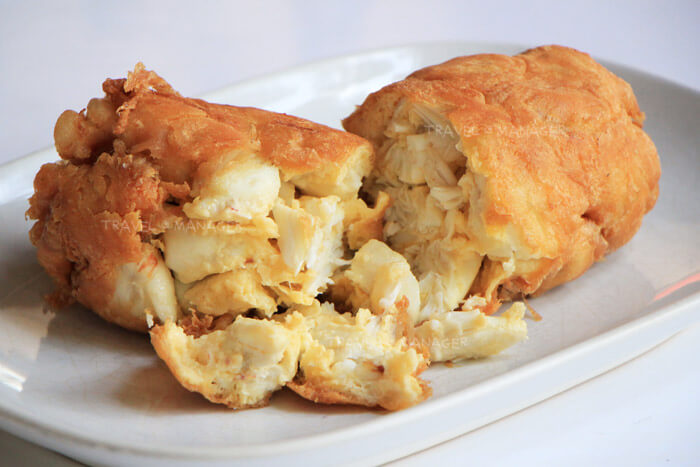
Jay Fai’s crab omlette [cr. Manager Online]
If you want to dine at Jay Fai’s ran tam sung, make sure to book or else you may end up waiting for hours. Popular dishes include the crab omelet, stir-fried crab with curry powder, seafood tom yum, and dried seafood tom yum sold at 700-1,000 baht. If you are prepared to spend a lot more, try rad na [ราดหน้า – noodles in thick gravy] with Mexican abalone at the price of 10,000 baht.
- Contribution
Jay Fai’s contribution to Thai food is evident. She elevates common street food, like the omelet, to a world-class gourmet delight, turning a common player into an MVP. Though the Thai street food scene is already renowned by its own accord, Jay Fai’s works helped make Thai street menus become better appreciated within the international fine-dining circle. Not only her food, but her personality and life have made her an unbeatable Thai food icon. After all, who can beat a woman with no background in professional training who singlehandedly earned a Michelin star that chefs around the world desire?
Chef Pom (M.L. Kwantip Devakula): The most-loved food creator
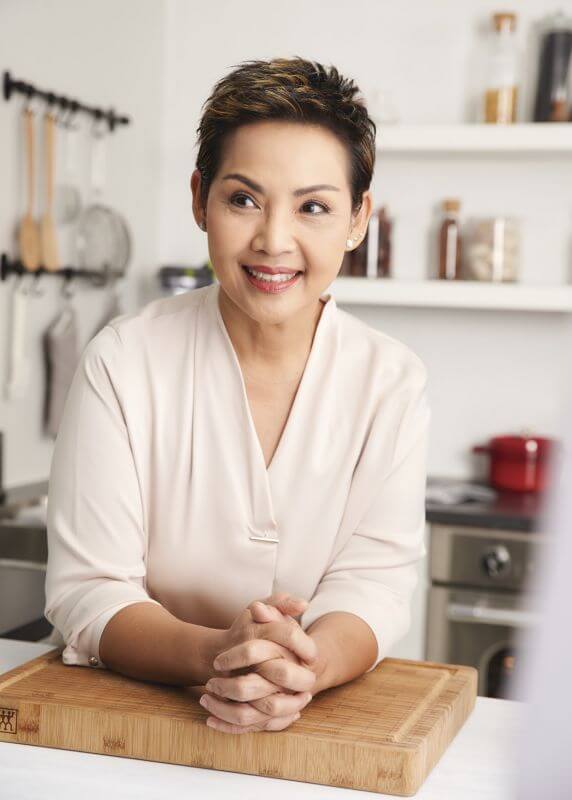
[cr. Daradaily]
Mom Luang Kwanthip Devakula, or Chef Pom is a great-great-grandchild of the King Rama IV. She is known as a food creator, teacher, judge on Master Chef Thailand, author of cookbook “Sam Rab” and creator of YouTube channel “Khrua Chan Soong” (High Zone Kitchen).
She said she never attended cooking school and didn’t even like cooking at first. But being born and raised in the Royal House of Devakula and playing in the palace kitchen since a young age was like living in a culinary boarding school all her life. She learned cooking from her mother who was great at Southern Thai food, her grandmother who prepared Western food even before Western cooking utensils were available in the country, and her grandmother’s cook who was an excellent traditional Thai cook. People from all walks of life who worked and lived at the palace were her human cookbooks.
She made visual notes and wrote down what she learned from her first-hand experiences. One of her amazing works is the “Thai curry paste periodic table” in which she systematically grouped the ingredients that all Thai curry pastes have in common and the ingredients that set them apart. Understanding the equation of the Thai curry universe is not difficult, and it allows us to appreciate Thai wisdom of blending strong-flavored herbs to achieve perfectly balanced tastes.
- Her definition of Thai food
According to Chef Pom, Thai food can be viewed as food eaten by Thais and made of Thai ingredients. For example, Thai duck stew is unique in its addition of lychee or pineapple. Both are tropical fruits found in the country. Their acidic quality softens the tough meat of Thai duck. This, however, does not mean that Thai food is free from other cultural influences or cannot evolve. An example is the famous Thai massaman curry, which originated from Islamic cuisine. The Thais adopted the dish and tweaked it with the sour, salty, and sweet flavors, as well as adding sweet potatoes to increase the curry volume. Some cooks even use pork instead of beef. The distinctive feature of Thai food is the “sweet and salty” technique. We highlight the sweetness of desserts with a touch of saltiness and enliven savory dishes with a slight note of sweetness. This balance of flavors also apply to other tastes, such as sour, bitter, etc.
In terms of modern Thai cuisine, Chef Pom believes that cooks can change the presentation of Thai food completely, so long as the essential signature of the dish is maintained. For instance, instead of a familiar beef in green curry, we can serve it in a form of Thai beef steak topped with thick green curry sauce and call it modern Thai cuisine. This act of adaptation is absolutely justifiable since all the main ingredients are still “essentially” Thai.
- Adaptation without distortion
It can be said that Chef Pom’s surroundings shaped her perspective of Thai food and, thus, her life philosophy “Being a Thai, one must understand Thai food.” Only when we properly understand the essence of Thai cuisine, will we be able to adapt it without distorting it.
Chef Pom ran a restaurant for a while before opening a cooking school. She makes sure that her students experience the authentic Thai food, its flavors, colors, visuals, and the ingredients behind those sensations. For example, the dark color and rich flavor of Pad Thai sauce doesn’t come from ketchup but from fish sauce, palm sugar, tamarind juice, and a touch of chili powder. It can be difficult to find these ingredients outside Thailand or Asian countries, but substituting them with ketchup only means one thing: you’re not making Pad Thai.
Her cooking show “High Zone Kitchen” targets urban people who live in high-rises where traditional Thai cooking might not be practical because they don’t have time or don’t want to disturb our neighbors. Here, she shows that some cheat codes are acceptable as long as the key idea is not compromised, such as using a blender in place of a pestle and mortar.

[cr. Youtube: High Zone Kitchen]
- Contribution
Chef Pom is a female chef with unparalleled expertise in all ranges of Thai cuisine. Cooking is her childhood and livelihood. She preserves and raises awareness of traditional Thai recipes and food culture with a progressive and forward mindset. If we are to praise someone as a legitimate guardian of Thai cuisine, it must be her.
Chef Bo (Duangporn Songvisava): Chef who does her bit for sustainability
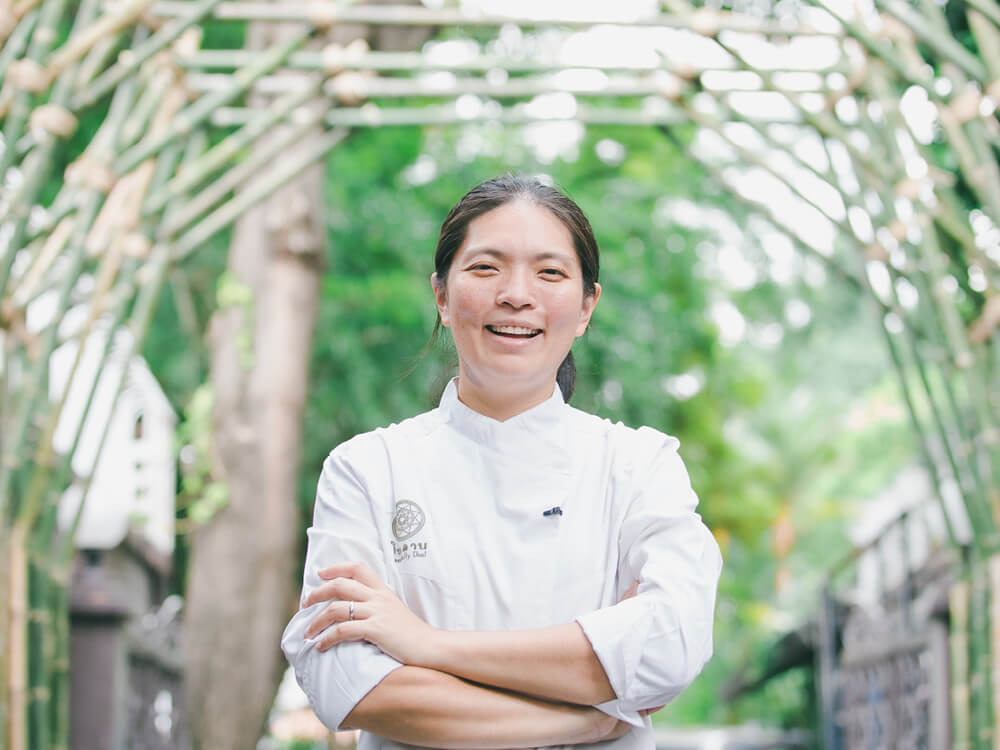
[cr. A Day Bulletin]
Chef Bo is a Thai-Taiwanese chef. She graduated in hotel management and restaurant and catering from Australia and holds a master’s degree in gastronomy from Le Cordon Bleu. She is married with two sons and her husband is also a chef.
After graduation, she worked in a Mediterranean restaurant in Thailand, where she realized that she knew next to nothing about the food of her home country. She then changed her career direction and opened Bo.lan in 2008 in Bangkok and won countless critical acclaims and awards from Thai and international food connoisseurs such as Asia’s Best Female Chef, 18 Best Restaurants in the World by World Restaurant Awards, and ultimately the Michelin star.
- Bo.lan and her quest for sustainability
Bo.lan is a creatively coined name that sounds smiliar to bo-ran [โบราณ], a Thai word for ancient or classic, and a combination of her nickname “Bo” and her husband’s name “Dylan.”
Bo.lan was an organic fine dining place. She sourced organic ingredients grown by small farmers and artisans in various fields, including Thai wine. She even grew a kitchen garden, installed solar panels, a water filtration system, and a waste separation system. At first, she only wanted to offer her customers an organic and healthy diet, and justly compensate farmers. But one evening, she turned around and saw a mountain of plastic water bottles in her kitchen. She asked herself how long her organic food supply would last if the environment was destroyed. The enlightenment that evening prompted her to pursue the path of zero food waste.
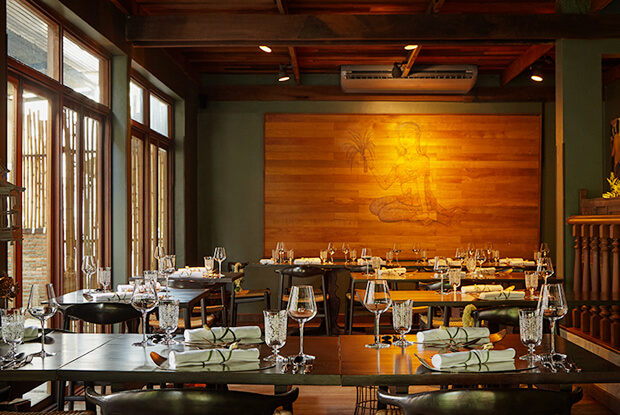
Bo.lan [cr. theworlds50best.com]
- Belief and Resilience
Bo.lan and Chef Bo grew together, but before she could reach her dream, Bo.lan had to bid farewell in the middle of COVID-19. Nevertheless, her dream and ambition to change the society and attitude of the Thai people toward food live on, if not stronger. As consumers in Thailand have yet to factor environmental impacts in their consumption, Bo’s mission is not yet complete.
Bo.lan has evolved into a learning platform that provides educational programs on food, sustainability, environment, and health. Bo.lan grocer is an organic supermarket that curates quality ingredients from small producers, forming a circle of food trust between farmers and consumers. Nearby is Bo.lan cooking school where students can learn cooking and food literacy. Chef Bo has successfully proven that a restaurant is just only one platform in the realm of food.
- Contributions
Bo.lan perfectly embodies the belief and aspiration of Chef Bo. From its inception, stellar expansion, to conclusion, it represents sustainability and resilience in which the end of one thing is a beginning of another thing. The COVID-19 crisis makes her stronger and better prepared for uncertainty. A single chef may not be able to change the society, but she will do her bit her best.
Chef Tam (Chudaree Debhakam): A veggies-hater turned chef
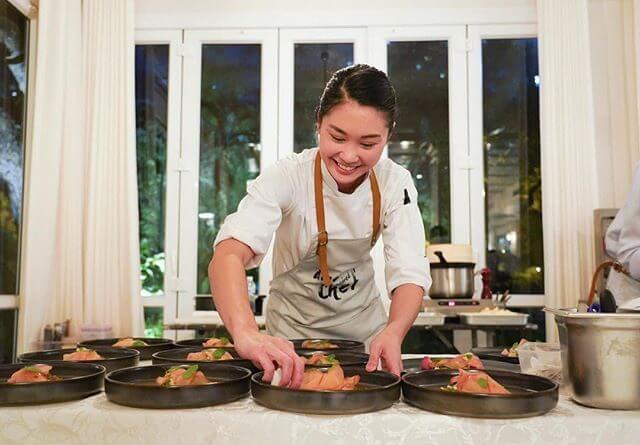
[cr. Hello! (Thailand)]
Chef Tam is the first winner of Top Chef, a famous Thai cooking show, but who would believe that this 29-year-old chef used to be a kid who didn’t like vegetables?
Her food career started when she studied nutrition science at the University of Nottingham, and took a short course at the International Culinary Center in New York, before landing a job at Blue Hill at Stone Barns. With hard work and dedication, she secured a position as the head of station and fish entremets. It was at this place where she started to look at green leafy in a totally new light and eventually fell in love with herbs. After learning about food safety and security, sustainability, and the farm-to-table concept, it dawned on her that in Thailand it was difficult for consumers to know how safe the food was, and farmers were subjected to price manipulation by intermediaries. To improve this situation and to take on a new mission of persuading those who shun vegetables to chomp on them, she headed back to Thailand and started Baan Tepa.
- Baan Tepa, the only chef’s table in Thailand with the farm to table concept
Baan Tepa is a chef’s table restaurant nestled in the house of her late grandparents in Hua Mak, Bangkok, but she plans for this place to be much more than that. Here, she has a kitchen garden that serves as a source of safe food for consumers. In this kitchen, nothing is wasted. Organic waste becomes compost for the garden, initiating a small sustainable food chain. As a learning center, Baan Tepa instills interest in Thai herbs and ingredients to intern chefs. As an enterprise, the place makes sure raw material suppliers receive a fair-trade price. And as a restaurant, the house serves customers a total of 10 courses. Chef Tam never reveals the menu, only the ingredients used to let diners to welcome new flavors and presentations without preconception. For example, she uses salted and dried catfish from the south to make chili paste accompanied with fancy side dishes, or makes Italian pasta stuffed with stink beans.
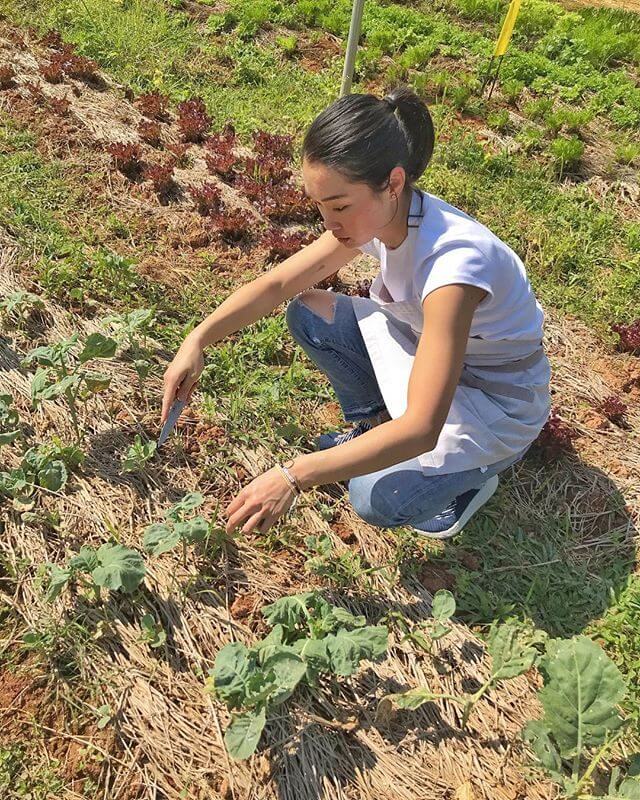 [cr. Hello! (Thailand)]
[cr. Hello! (Thailand)]
- Contributions
Chef Tam represents a new generation Thai female chef brimmed with creativity and courage. What is admirable is that the pillar of her business is sustainability, a truly universal concept for the well-being of the world.
**************************************
Thai food retains its charm through diversification. In this era, we see a street vendor rise to the status of world-class street food chef. We see a noble female chef who understands the essence of Thai food so well that she can conjure up endless surprises without losing the Thai identity. We have chefs who faced ups and downs and soldiered through hard work but never gave up on their dreams of changing the world of food they live in.
It is the resilience, emphasis on sustainability, openness, compassion, and ambition of Thai women who keep that Thai cuisine going and spice up the global food landscape.
References
World’s 50 Best Food
https://edition.cnn.com/travel/article/world-best-food-dishes/index.html
Je Fai
https://www.thairath.co.th/lifestyle/food/1148597
https://readspoonful.co/2020/01/22/jay-fai-success/
https://www.matichonacademy.com/content/review/article_15683
Chef Pom
https://www.youtube.com/watch?v=K3D1PShWp8s
https://www.youtube.com/watch?v=wL9lV3Cqwe4
https://www.youtube.com/watch?v=46-vNnRreq8
https://www.youtube.com/watch?v=OJhv_Lujtfk
Chef Bo
https://www.youtube.com/watch?v=zYTdpCwsKXk
https://en.wikipedia.org/wiki/Bo_Songvisava
https://adaybulletin.com/talk-guest-chef-duangporn-songvisava/40552
Chef Tam
https://th.hellomagazine.com/celebrity/exclusive-interviews/chef-tam-chudaree/
https://www.thairath.co.th/lifestyle/woman/hisoceleb/1915980
Author: Soonyata Mianlamai
Editor: Tayud Mongkolrat
April 12, 2022


